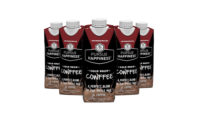
Finding Their Niche
by Lynn Petrak
Dairy manufacturers use demographics to develop and
market products that are truly tailor made.
In a country known for its diversity, the food and beverage market in the United States comprises a growing number of products tailored to certain groups within the population.
From an analogy standpoint, it’s not so much a
melting pot out there as it is a pantry stocked with clearly marked items
meant for specific usage. “It seems that adding value to products and
differentiating products is clearly happening,” says Tom Nagle,
senior vice president of marketing for the Washington, D.C.-based
International Dairy Foods Association (IDFA).
According to Nagle, demographically based products
ultimately have been spurred by competition. “I think it’s
driven by companies trying to understand what consumer preferences drive a
better business proposition,” he explains. “In a traditional
commodity business like fluid milk, for instance, you have processors
looking at the marketplace and seeing that it is clear consumers will pay
more for a certain product.”
Dairy manufacturers that have diversified their
product lines along particular consumer lines agree that it all boils down
to fulfilling need. Michael Neuwirth, senior director of public relations
for The Dannon Co., White Plains, N.Y., says it makes sense to evolve along
with your consumer base. “Dannon has a long history of identifying
consumer insights and translating them into products that fulfill an unmet
need,” he says, citing the introduction of Dannon Fruit-on-the-Bottom
yogurt in 1947 for those who didn’t care for the tart taste of plain
yogurt and the plethora of subsequent product launches centered on
preferences among distinct sets of customers.
Another yogurt maker, one that has based its business
on specializing in natural and organic products, also has heeded more
narrow demographic trends. Stonyfield Farm, Londonderry, N.H., offers a
product line that includes traditional varieties of spoonable and drinkable
yogurts as well as yogurts designed for young consumers. “I think
it’s an interesting observation that as segments within a population
are becoming larger and have distinctive needs, marketers try to serve
their needs with products incremental to their product line for those with
unmet needs. There is demand for it,” says Pete Lewis, product
manager for the company’s youth line of yogurts. “We have a
product targeted specifically for babies and toddlers and others for those
above that age range and we look at them differently in how we position and
market them.”
Dairy products and accompanying marketing programs
geared toward certain ethnic groups also are designed around the
preferences of buyers. “We market pretty much by region and by
customer, with what works well with the concentration in an area,”
says Sonny Dickinson, vice president of Eastern region sales for
Denver-based Colorado Ranchers Dairy Products Inc., which makes authentic
Hispanic-style cheeses. Marketed under the Queso Campesino name, these
products aim to appeal to those with Latino roots who have emigrated to the
United States, as well as to a growing number of other Americans. “As
a company,” Dickinson says, “we are committed to helping people
understand and adjust to the environment they are in and we try to do
that through products and promotions.”
For whatever group a dairy product is targeted to,
Nagle says that for it to be successful, it has to truly deliver on the
defined need. “It is product formulation that actually aligns with a
real consumer need and it is how the product is presented to the
consumer,” he says. “That includes not just packaging, but
brand identity, merchandising, advertising and the whole marketing
mix.”
The crux of all that? Research conducted by
manufacturers as well as data offered by industry organizations like IDFA
and others. Nagle emphasizes: “You can’t do this without market
research.”
Little Mouths, Big Market
One of the most notable and research-based niches in
the dairy industry is the youth market. Compared to a generation ago, which
grew up with only a few kid-oriented brands, young people now are wooed by
all types of food and beverage marketers.
“Today’s youth is smarter and are more
educated consumers than ever before. This is primarily a result of the
media that has proliferated and fractured at the same time it has become
subservient to the consumer,” observes Stan Harris, chief marketing
officer for Bravo Foods International Corp, a North Palm Beach, Fla.-based
manufacturer of flavored milks, including the Slammers® line for
youngsters.
Dairy products that appeal to kids — from babies
6 months old all the way to teenagers — certainly run the gamut.
Indeed, items for youngsters are evident in nearly ever dairy sector.
The yogurt category, arguably, is one of the earliest
and most prolific innovators, with manufacturers attracting children
through flavors, sizes and packages that appealed to their tastes. Major
brands like Dannon and Yoplait (a division of General Mills) introduced
specialty kid-friendly yogurts more than a decade ago, as sub-brands like
Danimals and Go-Gurt, respectively, struck a chord among youngsters and
their parents and caregivers.
“In the historical development of the U.S.
yogurt market, very few of the early adopters were kids, despite the
obvious nutritional benefits of a food product like yogurt for the
healthy development of kids,” Neuwirth says. “In large part,
this is because no companies had developed products specifically for kids,
and perhaps moms didn’t think about the benefits of a product that
they chose for themselves was also right for their kids. With this insight,
we developed the Danimals brand in the 1990s and its unique packaging that
appeals to kids and lets mom know that this is a great-tasting and
nutritious snack for kids.”
It wasn’t long before more varieties of Danimals
came to the fore, such as drinkable Danimals and Danimals with mix-in
sprinkles, among others. The Yoplait brand, too, continually added new
items, such as Trix® branded yogurt (a tie-in to its parent company’s
cereal) and Go-Gurt featuring movie and other licensed character tie-ins.
Today, those product lines have been amplified as
well, with SKUs for different age brackets. Compare Danimals for youngsters
with Dannon’s XL yogurt smoothie, with a sleek black bottle and a
larger size designed to appeal to older kids. “Even within the kids
segment of yogurt, there is niching — or perhaps splintering
— taking place based on considerations such as age and
packaging format. Within the kids segment, examples of this splintering are
cups, drinks and tubes, and they may not be mutually exclusive,”
Neuwirth says. “Obviously the organic and natural segment is also a
meaningful consideration for moms. Each sub-segment, or fragment, brings
added value to the consumer and the category.”
When it comes to organic and natural, Stonyfield Farm
offers yogurts that are both natural and organic and that meet a range of
age groups within the youth market. The company’s YoBaby line of
yogurt, for instance, is entirely driven by a particular base, namely
babies and toddlers via their gatekeepers.
“YoBaby is made with whole milk, because the
American Academy of Pediatrics recommends whole milk in dairy for kids up
to age 2,” Lewis explains, adding that the package featuring a
baby’s face and the word “baby” is a clear signal
to parents that the product is just for their infants and toddlers.
“It’s a unique item — it’s more of a baby food in
the yogurt section.”
Reflecting the demographic splintering trend,
Stonyfield Farm is now branching out. In addition to a new YoBaby milk and
cereal variety with added DHA, the company is working on its products
and programs aimed at older youths. “Kids yogurt as a category
wasn’t really popular until the last several years and I suspect kids
ages five or six today, with those used to eating or drinking yogurt, will
grow,” Lewis says. Stonyfield Farm’s response to that trend is
a line of YoKids yogurt products, set to be unveiled by this fall.
Beyond yogurt, other dairy producers have looked to
capitalize on the power of youth. As Nagle points out, the milk gallon has
long been and likely will continue to be the consummate dairy staple for
families, but that doesn’t mean fluid milk manufacturers
haven’t learned how to sell their product in enticing, kid-friendly
formats. He uses the example of string cheese: “The moment someone
says that a kid package for milk is the white gallon, I’ll tell them
that it’s like the mozzarella cheese guys saying the best package for
kids is a two-pound block of cheese.”
Over the past decade, the advent of single-serve
flavored milks fueled new excitement in fluid milk, and a lot of the
success of that sub-category was due in part to the products’ appeal
among smaller drinkers. Once dairies figured out that plastic milk bottles
and their accompanying colorful sleeves with high-impact graphics caught
consumers’ eyes, it wasn’t long before they determined that
young milk consumers could be enticed to ask for such products through the
use of fun flavors and splashy bottles.
To be sure, although single-serve and larger bottles
of milk in flavors like chocolate and strawberry, and more exotic varieties
like candy bar-inspired flavors, are purchased by many adults, they have an
undeniable cache among younger consumers.
Some of the latest entries in flavored milk aimed at
kids come from Bravo Foods, which recently teamed up with General Mills for
a new Slammers Trix and Cocoa Puffs® flavored milk line inspired by General Mills cereals.
“Kids everywhere know and love the Trix Rabbit
and Sunny the Cuckoo Bird, the spokes-characters for Trix and Cocoa Puffs
respectively,” Harris says. “We’ve all had the experience
of enjoying the milk at the bottom of our cereal bowl, and now everyone can
enjoy this great tasting flavor in a better-for-you real milk
drink.”
Other dairy categories also include several types of
products directed squarely at youngsters. Several types of kid-friendly
cheeses are on the market, for example, from traditional string cheese to
snacking cheeses like Sargento Foods’ star and moon-shaped cheeses,
launched a couple of years ago.
Similarly, although kid-themed products aren’t
anything new in ice cream and novelties, such highly targeted frozen treats
continue to expand and in some respects, splinter into different segments.
Novelties inspired by the television show “Fear Factor” from
the Good Humor brand, for instance — with designs like eyeballs and
creepy bugs — are likely to be clamored for by older children.
What Women Want
While those younger than 18 get a lot of attention in
R&D and marketing departments in dairy companies, so too do
health-conscious adults, especially women watching their diet from a
nutrition or weight-loss perspective.
Again, there are many better-for-you products to be
found in the yogurt category. Yoplait’s Nouriche smoothie, for
example, is largely directed at nutrition-minded female consumers with a
product formulation, package and supporting advertising and marketing
efforts designed to meet a women’s dietary and lifestyle needs.
Dannon also has products that have a definite appeal
among women. “Health-oriented women are increasingly looking to foods
as a means to help them feel better and accomplish their goals, whether it
be weight management or digestive regularity,” Neuwirth says.
“Products and their marketing that are carefully conceived to deliver
a single-minded proposition that is relevant to active,
health-conscious women are doing very well.”
To that end, Dannon’s Light & Fit and
Activia yogurts are geared toward those looking for certain dietary
impacts, many of whom are female consumers. “Light & Fit is all
about being your partner in weight management, which is a major theme in
the lives of active, health-oriented women. The great taste, nutrient
values and 70 calories benefit all resonate in an on-the-go package,
whether it be a spoonable product or a drinkable,” Neuwirth says.
“As the first probiotic lowfat yogurt, Activia helps to regulate your
digestive system, which is of keen interest to many women and men in this
country.”
Another better-for-you dairy category that has surged
remarkably is ice cream. Major brands like Dreyer’s/Edy’s, Good
Humor-Breyers and Dean Foods, in addition to large regional brands like
Pierre’s French Ice Cream and the Smith Dairy Ruggles line, have
broad and ever-expanding better-for-you offerings. The latest
“darlings” among ice cream manufacturers are no-sugar-added
(NSA) and lowfat varieties, continuing explorations launches during the
low-carb craze.
Not to be overlooked are other dairy categories that
include a range of better-for-you alternatives for women and other core
consumers, such as lowfat cheese, fortified cottage cheese and reduced fat
milks, Nagle, for his part, sees more opportunities for milk; even thought
it is a vitamin-packed functional beverage in its own right, there are
opportunities to attract more health-oriented adults and diet-oriented
women. “There has been work in the industry on special formulations
that meet the needs of kids and pregnant women,” he says. “You
see it in other product categories, and it seems fluid milk is headed more
in that direction.”
Leveraging Diversity
Another area of demographically-driven markets is the
ethnic market. Itself quite diverse, the ethnic market includes a growing
number of dairy products developed for people of a certain heritage.
As the Italian market has become mainstream, the
Hispanic market is now the fastest-growing ethnic group in the United
States, with a retail and foodservice presence to show it.
In the supermarket, food is moving out of the aisle
reserved for taco shells and salsa and integrated more into other food
categories. Today’s cheese cases and delis, for example, include more
Hispanic-style cheeses, from national brands like Kraft as well as regional
producers.
Queso Campesino is one brand that is simultaneously
marketing its authentic Hispanic cheeses to its core base and expanding its
business among a rapidly growing segment of “traditional”
American consumers. The Hispanic-owned company regularly adds to its
offering of authentic cheese, such as its new cotija, a hard cheese similar
to parmesan.
According to Dickinson, new product development is
based on stated needs and takes into account different factors. It is on
the promotion side, he says, where such distinctions most often come into
play. “Say you have first generation [Hispanic immigrant consumers]
— you’re going to position your products differently than you
would on the second generation,” he says, adding that
second-generation Latinos are seeking convenience-oriented products like
exact-weight and grated cheeses to suit their busy lifestyles.
The team at Queso Campesino also takes into account
subtle but key differences in consumers in its retail merchandising
efforts. “When the Hispanic customers — especially the Mexican
customers, which is the largest category — see cotija, they know what it
is,” Dickinson explains. “But they are still learning to shop
the store and have to get used to where it is.”
The burgeoning Hispanic population in the United
States has spurred other dairy manufacturers to develop new tailored
products and promotions.. Some flavored milk companies, for instance, are
launching Hispanic-style flavors, like mango or banana, while groups like
IDFA help marketers learn about the important regional and ethnic
differences within the Hispanic market.
Ice cream companies also are reaching out to Latinos,
with products like Tampico (manufactured by Dean Foods) becoming available
in flavors like guava and coconut. Yogurt makers, too, are keeping Hispanic
consumers in mind. “For the first time in Dannon’s history, we
started to advertise to U.S. Hispanics when we launched Activia earlier
this year,” Neuwirth says. “We have seen a very positive
initial response to this.”
What About the Others?
With products aimed at children, women, older adults,
those on restricted diets and Hispanic consumers, where does that leave
other demographic groups, such as adult men or young adults in their 20s?
There are plenty of products to suit their needs as
well, indicated in dairy products’ vast flavor, packaging and
nutrient profile differences. “Men are indeed coming around to enjoy
more yogurt,” Neuwirth says. “We know that men enjoy all of our
products to varying degrees, versus their female counterparts.”
Nagle says other consumer groups are hardly forgotten.
“That doesn’t mean that companies aren’t thinking about
those segments,” he says, sharing an example. “Single-serve
flavored milks aren’t just a story about teenagers and youths, but
about adult men and women, depending on the venue.”
Lynn Petrak is a freelance journalist based in the
Chicago area.
$OMN_arttitle="Finding Their Niche";?>

